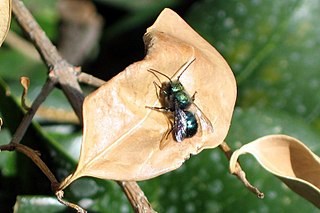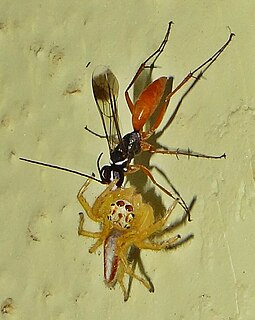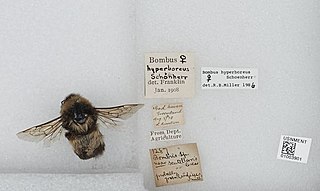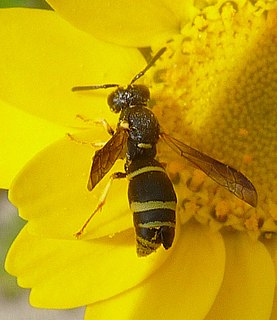
Megachilidae is a cosmopolitan family of mostly solitary bees whose pollen-carrying structure is restricted to the ventral surface of the abdomen. Megachilid genera are most commonly known as mason bees and leafcutter bees, reflecting the materials from which they build their nest cells ; a few collect plant or animal hairs and fibers, and are called carder bees, while others use plant resins in nest construction and are correspondingly called resin bees. All species feed on nectar and pollen, but a few are kleptoparasites, feeding on pollen collected by other megachilid bees. Parasitic species do not possess scopae. The motion of Megachilidae in the reproductive structures of flowers is energetic and swimming-like; this agitation releases large amounts of pollen.

Mason bee is a name now commonly used for species of bees in the genus Osmia, of the family Megachilidae. Mason bees are named for their habit of using mud or other "masonry" products in constructing their nests, which are made in naturally occurring gaps such as between cracks in stones or other small dark cavities. When available, some species preferentially use hollow stems or holes in wood made by wood-boring insects.

Osmia lignaria, commonly known as the orchard mason bee or blue orchard bee, is a megachilid bee that makes nests in reeds and natural holes, creating individual cells for its brood that are separated by mud dividers. Unlike carpenter bees, it cannot drill holes in wood. O. lignaria is a common species used for early spring fruit bloom in Canada and the United States, though a number of other Osmia species are cultured for use in pollination.

Potter wasps, the Eumeninae, are a cosmopolitan wasp group presently treated as a subfamily of Vespidae, but sometimes recognized in the past as a separate family, Eumenidae.

Philanthus triangulum, commonly known as the European beewolf, bee-killer wasp or the bee-eating philanthus, is a solitary wasp that lives in the Western Palearctic and Afrotropics. Although the adults of the species are herbivores, the species derives its name from the behaviour of the inseminated females, who hunt Western honey bees. The female places several of its paralysed prey together with an egg in a small underground chamber, to serve as food for the wasp larvae. All members of the genus Philanthus hunt various species of bees, but P. triangulum is apparently the only one that specialises in Western honey bees.

Mass provisioning is a form of parental investment in which an adult insect, most commonly a hymenopteran such as a bee or wasp, stocks all the food for each of her offspring in a small chamber before she lays the egg. This behavior is common in both solitary and eusocial bees, though essentially absent in eusocial wasps.

Bombus hyperboreus is a species of Arctic bumblebee with a circumpolar distribution. The species is primarily found in the arctic areas of Greenland, northern Scandinavia, and Russia. In 2015 the nearctic species, Bombus natvigi, was separated from this species, based on genetic analysis. Accordingly, Bombus hyperboreus is limited to the Palaearctic, despite older literature listing this species as occurring in the Nearctic.

Osmia bicornis, synonym Osmia rufa, is a species of mason bee, and is known as the red mason bee due to its covering of dense gingery hair. It is a solitary bee that nests in holes or stems and is polylectic, meaning it forages pollen from various different flowering plants. These bees can be seen aggregating together and nests in preexisting hollows, choosing not to excavate their own. These bees are not aggressive; they will only sting if handled very roughly and are safe to be closely observed by children. Females only mate once, usually with closely related males. Further, females can determine the sex ratio of their offspring based on their body size, where larger females will invest more in diploid females eggs than small bees. These bees also have trichromatic colour vision and are important pollinators in agriculture.

Osmia bicolor, the two-coloured mason-bee, is a Palearctic species of bee in the genus Osmia. It is outstanding amongst other megachilid bees in that it nests in empty snail shells.

The European potter wasp or European tube wasp is a species of potter wasp. As an imago (adult), the female collects as many as 20 caterpillars for each nest, which consists of a single cell. Her larval offspring then feed on these inside the nest, which is sealed with mud arranged by her. As adults, they eat nectar and aphid honeydew. Males cannot sting, and the sting of a female is not painful. They can be found on windows, foraging for nectar on flowers, or searching out small cracks or holes in which to nest.
Osmia avosetta is a species of mason bee. It is solitary by nature, and is notable for its distinctive use of flower petals to construct nests for its larvae.

Coelioxys, common name leaf-cutting cuckoo bees or sharp-tailed bees , is a genus of solitary kleptoparasitic or brood parasitic bees, belonging to the family Megachilidae.

Megachile texana, the Texas leafcutter bee, is a species of bee in the family Megachilidae. It was first described by the American entomologist Ezra Townsend Cresson in 1878. It is native to the United States and southern Canada.
Osmia xanthomelana, the large mason bee, is a species of mason bee in the genus Osmia. It has a wide distribution in the Palearctic but it is rare wherever it occurs and, for example, in Great Britain it has a highly restricted distribution, although in the past it was a little more widespread there.

Osmia uncinata, the pinewood mason bee, is a species of solitary bee from the family Megachilidae It is an Arctic-alpine species which is found in the northern Palearctic, in the United Kingdom it is a Biodiversity Action Plan priority species.

Osmia caerulescens, the blue mason bee, is a species of solitary bee from the family Megachilidae. It has a Holarctic distribution extending into the Indomalayan region, although its presence in the Nearctic may be due to human assisted introduction.

Chrysis viridula is a Western Palearctic species of cuckoo wasp, first described by Carl Linnaeus in 1761. Chrysis viridula is included in the genus Chrysis, and the family Chrysididae. It is a parasitoid of a number of species of eumenid wasp, mainly those in the genus Odynerus.

Symmorphus bifasciatus, the willow mason-wasp, is a species of potter wasp, from the subfamily Eumeninae of the social wasp family Vespidae which is widely distributed in the Palearctic region.

Odynerus spinipes, the spiny mason wasp, is a species of potter wasp from western Europe. It is the type species of the genus Odynerus, being first described by Carl Linnaeus in his landmark 1758 10th edition of Systema Naturae.

Monosapyga clavicornis is a hymenopteran from the family Sapygidae. The species is common and not endangered.

















